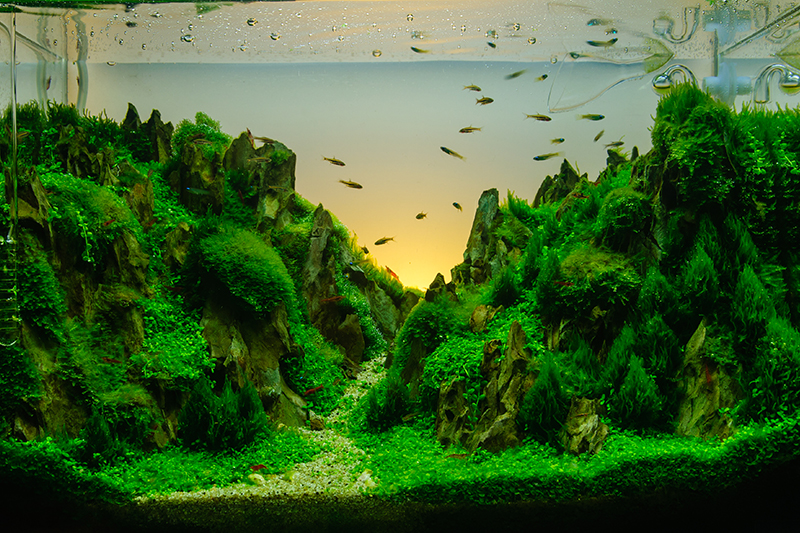Is your fish tank looking a little dull? If it’s time to bring new life to your aquarium (in a design sense), here’s some expert advice for aquascaping. Not only will a fresh environment make your fish happier, but it has the potential to revitalise your home, too.
Aquascaping – The basics
If you think about your aquarium like a garden, with each plant, pebble and ornament having its own place, you’ll understand the principles of aquascaping. Taking care when laying out your fish tank and using design ideas that can be applied to your home’s interior will create a fish-friendly environment. The added benefit is that your aquascaped fish tank will bring its own ambience to your home, something that can be enjoyed long term. The great thing is that the basics of aquascaping act more as guides that you can play with based on your personal preference so your finished fish tank is entirely your creation – one that suits your fish and your home. Be sure to chat with a Petbarn team member if you need any advice on setting up your tank or would like help choosing the elements of your tank.
Expert advice
Before you dive straight into aquascaping your tank, some expert advice from a talented aquascaper will help you do your best work. Daniel Cano, director of Aquarium Industries, is full of ideas for creating an environment that benefits your fish and your home. Here’s his advice for aquascaping success.
What are some tips for creating an environment your fish will love and looks great?
“Research before you buy,” says Daniel. “Understand that many species of fish require different water parameters and different environments. So taking inspiration from their natural environments is the most ideal method. Look at the kinds of aquatics plants, rocks, wood and substrates that are found in the same region as your fish. This is called a biotope.”
How do you avoid a cluttered look in a fish tank?
“Less is more. This saying couldn’t be more relevant when it comes to making an aquarium look attractive. The key to designing an uncluttered aquarium isn’t in what you add to the aquascape – it’s what you don’t add.”
What are some design rules that can apply to your fish tank, too?
The rule of thirds
“This is a principle of photography and is often used when planning. The rule of thirds divides an image up into three sections we use these intersecting points to frame and focus what we what the viewer to see. In the case of aquariums, using this rule brings out the natural beauty of a living environment as we try and re-create a river, stream or lake on a blank canvas adding points of interest in these intersecting zones.”
Size is everything.
“When aquascaping we want to make the tank look as big as possible and this is achieved by using scale to our advantage. When selecting ornaments like rocks or driftwood you need to be aware that placing a large piece of wood or rock in a small tank will emphasise the lack of space. But adding a smaller piece with more interesting features like twisting branches or more detail can give the tank a more natural look increasing its presence in the tank and thus adding to its sense of scale. The same is true when selecting plants, some of the more popular aquascaping plants have small leaves which again create a pleasing scale to the aquarium.”
How many types of plants should you include in your aquarium and why?
“As many as you like, but remember that you want it to look pleasing to the eye and simply adding as many as you can fit will make it look cluttered and disorganised,” says Daniel. “Create a layout plan before you start and keep in mind the adult size of a plant when selecting and add plants in the foreground, mid ground and background. It’s important to keep a clear distinguished line between them otherwise the tank can look too busy and some plants will potentially obscure other plants as they grow if not correctly placed.”
What are some key things to keep in mind when choosing plants?
“It is important to understand how each species grows before you plant them, this will give you more control of the finished product. Plant for the future! Planting your tank is fun, but you need to remember that planting may not give you the look you want right away – patience is required. Wait for the plants to grow and fill spaces, adjusting as needed. Aquatic plants need care similar to any other garden; feeding, trimming and replanting are all part of making your aquatic garden grow, so researching what products, substrate and fertilisers you’ll need will make the process a lot easier.”
How often should you devote time to the maintenance of your aquascape?
“Creating your aquascape can take hours at first, but then only general maintenance is required. Followed up by trimming and pruning if you have plants – just like any garden. Depending on your aquascape, weekly maintenance of 30 minutes to one hour should be sufficient.”
For more information about aquascaping or the great range of products for your aquarium, be sure to check in with a friendly Petbarn team member. You can also have your aquarium’s water tested by the Petbarn team to ensure your fish are living in a healthy environment.

